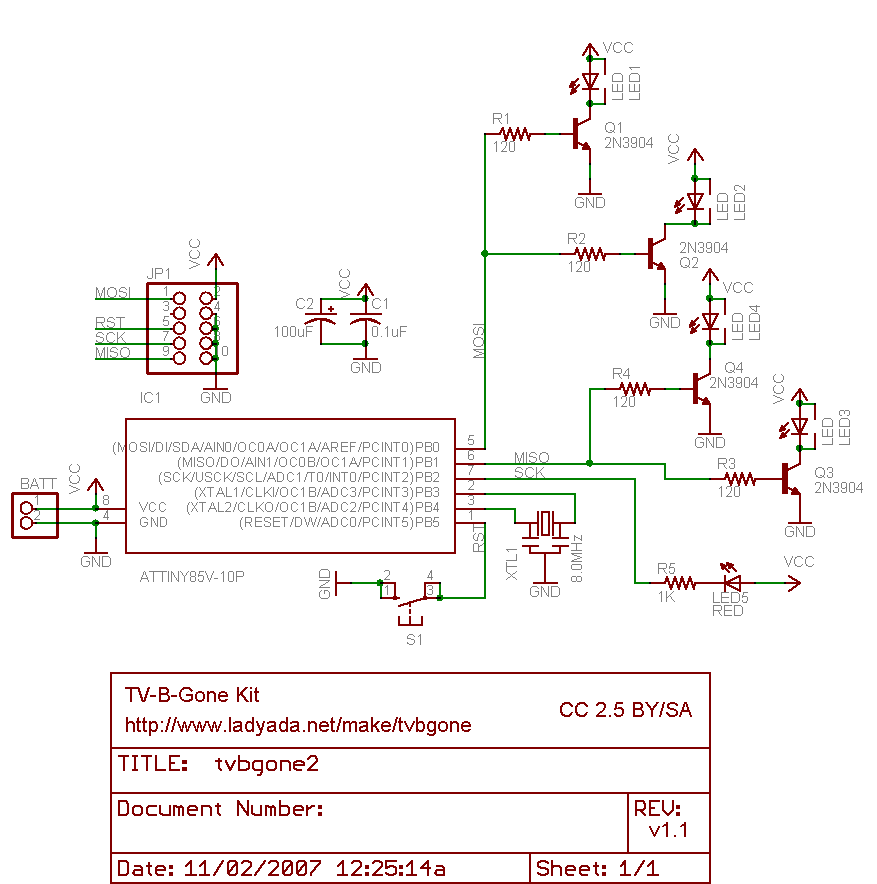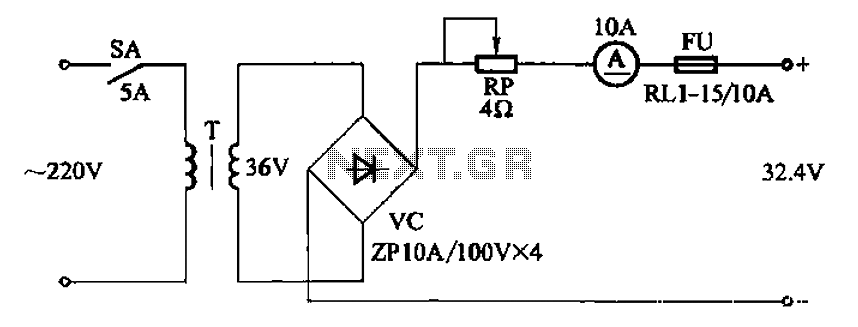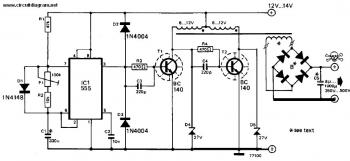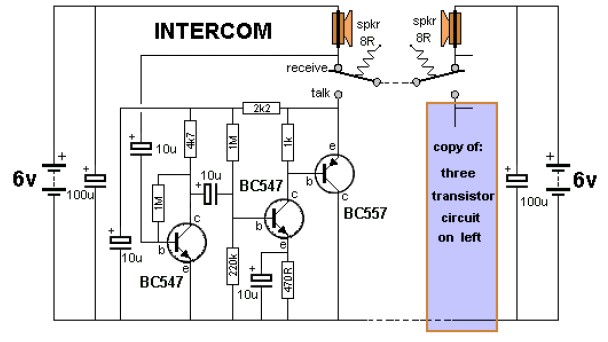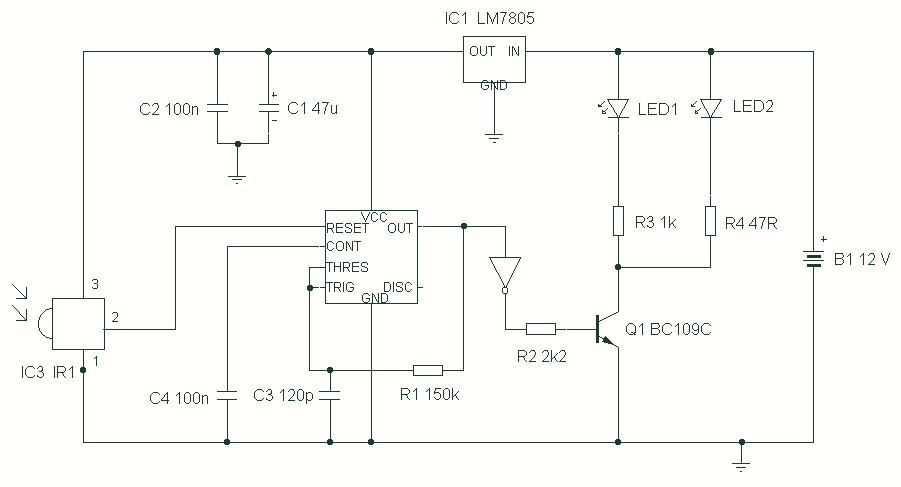
Wogglebug circuit
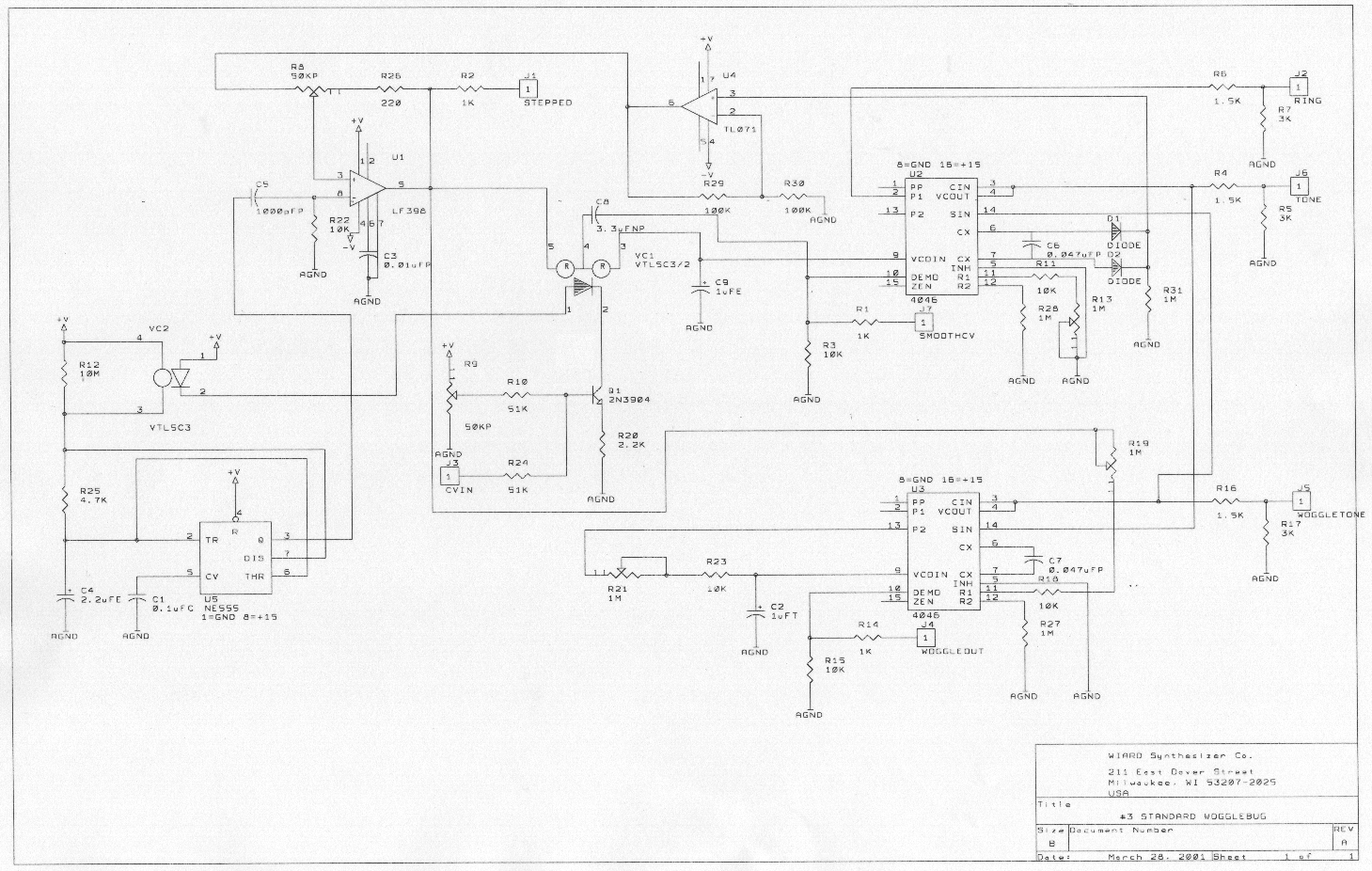
A second RM output and a sync input have been added to the 555 timer circuit. The sync input is derived from one of Rene Schmitz's voltage-controlled oscillators (VCOs). There are two transistors in the PCB images that lack specifications; one is included in the Wiard schematics, while the other may be found in the VCO3 circuit referenced. Regarding capacitor types, it is understood that 'C' denotes ceramic, 'P' refers to poly (polystyrene, polyester, polypropylene), and 'T' indicates tantalum. The designations 'FP' and 'NP' require clarification. Four pairs of pads remain unassigned, which may serve as returns to V+/- and ground for some potentiometers. One pair is located just north of the LF398, with one side grounded and the other connected to V-. A request for a list of potentiometer names has been made, as the block diagram on the Wiard site has not provided clarity. It appears that Grant's production model includes additional features not shown in the basic schematic, such as disturbance control voltages (CVs) and several LEDs. The Wiard production Wogglebug is a more advanced version, and a second LF398 is likely involved. The Wogglebug #3, while simpler than the production version, remains an excellent module that could serve as a foundation for further modifications. Additional circuits designed by Dr. Mabuse are available on the Wiardgroup Yahoo groups. There is an acknowledgment of the cryptic nature of the parts placement in the layout, with an intention to create a more user-friendly version. However, there are persistent issues with the PCB, despite thorough checks for errors or improper soldering.
The circuit described incorporates a 555 timer integrated circuit, which is widely utilized in various timing and oscillation applications. The addition of a second RM output enhances the versatility of the circuit, allowing for multiple output signals that can be synchronized or modulated. The sync input, derived from a voltage-controlled oscillator, enables the 555 timer to operate in conjunction with other oscillators, facilitating synchronized operations in modular synthesizer setups.
The mention of unspecified transistors indicates that further investigation is necessary to identify their roles within the circuit. The Wiard schematics, which provide essential details for the circuit's layout and functionality, should be consulted for clarification. The VCO3 circuit may also contain relevant information regarding the unidentified transistor.
Capacitor designations are critical for ensuring proper functionality. The standard classifications of capacitors (ceramic, poly, tantalum) indicate the materials used and their respective properties, which can affect performance in timing and filtering applications. The 'FP' and 'NP' designations warrant further investigation to understand their significance in this context.
The unassigned pads on the PCB suggest potential locations for additional connections, possibly for voltage returns associated with potentiometers. The configuration near the LF398, which connects to ground and V-, should be verified to ensure it aligns with the intended circuit design. The identification of potentiometer names is crucial for proper integration and functionality, particularly when working from a block diagram that may not provide comprehensive details.
The mention of Grant's production model highlights the evolution of the design, with enhancements that may not be documented in earlier schematics. The inclusion of disturbance CVs and LEDs indicates an effort to expand the module's capabilities, providing users with more control and visual feedback.
The Wogglebug circuit represents a more complex iteration of the basic module, incorporating additional features that enhance its functionality within a synthesizer context. The use of a second LF398 suggests a more intricate design that could improve signal processing or modulation capabilities.
For those interested in modifications or enhancements, resources such as the Wiardgroup on Yahoo provide community-driven insights and additional circuits designed by experienced users. These can serve as valuable references for expanding the functionality of the Wogglebug or similar modules.
Overall, the circuit presents a rich platform for experimentation and development, with opportunities for customization and enhancement through careful analysis of the schematics and available resources.I added a second RM output and a sync input to the 555. The latter is based off of one of Rene Schmitz VCOs. ( ) ok, thank you. i asked because on the two PCB pictures above there are e. g. two transistors without any specification. the wiard schematics contains one of them and the other one i guess i`ll have to look for in the VCO3 circuit you mentioned. ok, thank you. i asked because on the two PCB pictures above there are e. g. two transistors without any specification. the wiard schematics contains one of them and the other one i guess i`ll have to look for in the VCO3 circuit you mentioned. As far as the capacitor types go i am resonably comfortable that C denotes ceramic, P is poly (-styrene -ester -propelyene ), T is tantalum.
But what give with the FP and NP designations There are 4 pairs of pads left blank, I am imagining that several are for returns to V+/- and ground for some of the pots Is this correct There is a pair open just north of the 398, one side grounded the other jumpered to V-. Does anyone have a handy list of the names for the potentiometers I have been trying to work it out from the block diagram on the Wiard site to no avail.
It would also seem that Grant`s production model has a good bit more packed into it than his basic schem shows, such as the disturb CVs and a bunch of lovely LEDs. any leads on these extras As far as the capacitor types go i am resonably comfortable that C denotes ceramic, P is poly (-styrene -ester -propelyene ), T is tantalum.
But what give with the FP and NP designations There are 4 pairs of pads left blank, I am imagining that several are for returns to V+/- and ground for some of the pots Is this correct There is a pair open just north of the 398, one side grounded the other jumpered to V-. Does anyone have a handy list of the names for the potentiometers I have been trying to work it out from the block diagram on the Wiard site to no avail.
It would also seem that Grant`s production model has a good bit more packed into it than his basic schem shows, such as the disturb CVs and a bunch of lovely LEDs. any leads on these extras The Wiard production Wogglebug is a more sophisticated version. I tried working out what was behind the front panel at some point. not sure where my notes are for that. I`m pretty sure a second LF398 is involved. I`ll see if I can find my stuff. Obviously, Grant isn`t going to give out his secret recipe. Despite the fact that the Wogglebug #3 is simpler than the production version, it is still a fantastic module.
You could always start with that and hack other stuff onto it. The Wiardgroup on yahoo groups has some extra add-onn circuits that Dr. Mabuse designed. Might want to check those out. These are good questions. I never realized that people would be interested in this layout, which is why the parts placement is still in its cryptic format. I`ll try to whip up one that`s more user friendly. This is definitely not right. I already checked the PCB for obvious errors or solder where it should not been. found some, fixed all. still the same problem. 🔗 External reference
The circuit described incorporates a 555 timer integrated circuit, which is widely utilized in various timing and oscillation applications. The addition of a second RM output enhances the versatility of the circuit, allowing for multiple output signals that can be synchronized or modulated. The sync input, derived from a voltage-controlled oscillator, enables the 555 timer to operate in conjunction with other oscillators, facilitating synchronized operations in modular synthesizer setups.
The mention of unspecified transistors indicates that further investigation is necessary to identify their roles within the circuit. The Wiard schematics, which provide essential details for the circuit's layout and functionality, should be consulted for clarification. The VCO3 circuit may also contain relevant information regarding the unidentified transistor.
Capacitor designations are critical for ensuring proper functionality. The standard classifications of capacitors (ceramic, poly, tantalum) indicate the materials used and their respective properties, which can affect performance in timing and filtering applications. The 'FP' and 'NP' designations warrant further investigation to understand their significance in this context.
The unassigned pads on the PCB suggest potential locations for additional connections, possibly for voltage returns associated with potentiometers. The configuration near the LF398, which connects to ground and V-, should be verified to ensure it aligns with the intended circuit design. The identification of potentiometer names is crucial for proper integration and functionality, particularly when working from a block diagram that may not provide comprehensive details.
The mention of Grant's production model highlights the evolution of the design, with enhancements that may not be documented in earlier schematics. The inclusion of disturbance CVs and LEDs indicates an effort to expand the module's capabilities, providing users with more control and visual feedback.
The Wogglebug circuit represents a more complex iteration of the basic module, incorporating additional features that enhance its functionality within a synthesizer context. The use of a second LF398 suggests a more intricate design that could improve signal processing or modulation capabilities.
For those interested in modifications or enhancements, resources such as the Wiardgroup on Yahoo provide community-driven insights and additional circuits designed by experienced users. These can serve as valuable references for expanding the functionality of the Wogglebug or similar modules.
Overall, the circuit presents a rich platform for experimentation and development, with opportunities for customization and enhancement through careful analysis of the schematics and available resources.I added a second RM output and a sync input to the 555. The latter is based off of one of Rene Schmitz VCOs. ( ) ok, thank you. i asked because on the two PCB pictures above there are e. g. two transistors without any specification. the wiard schematics contains one of them and the other one i guess i`ll have to look for in the VCO3 circuit you mentioned. ok, thank you. i asked because on the two PCB pictures above there are e. g. two transistors without any specification. the wiard schematics contains one of them and the other one i guess i`ll have to look for in the VCO3 circuit you mentioned. As far as the capacitor types go i am resonably comfortable that C denotes ceramic, P is poly (-styrene -ester -propelyene ), T is tantalum.
But what give with the FP and NP designations There are 4 pairs of pads left blank, I am imagining that several are for returns to V+/- and ground for some of the pots Is this correct There is a pair open just north of the 398, one side grounded the other jumpered to V-. Does anyone have a handy list of the names for the potentiometers I have been trying to work it out from the block diagram on the Wiard site to no avail.
It would also seem that Grant`s production model has a good bit more packed into it than his basic schem shows, such as the disturb CVs and a bunch of lovely LEDs. any leads on these extras As far as the capacitor types go i am resonably comfortable that C denotes ceramic, P is poly (-styrene -ester -propelyene ), T is tantalum.
But what give with the FP and NP designations There are 4 pairs of pads left blank, I am imagining that several are for returns to V+/- and ground for some of the pots Is this correct There is a pair open just north of the 398, one side grounded the other jumpered to V-. Does anyone have a handy list of the names for the potentiometers I have been trying to work it out from the block diagram on the Wiard site to no avail.
It would also seem that Grant`s production model has a good bit more packed into it than his basic schem shows, such as the disturb CVs and a bunch of lovely LEDs. any leads on these extras The Wiard production Wogglebug is a more sophisticated version. I tried working out what was behind the front panel at some point. not sure where my notes are for that. I`m pretty sure a second LF398 is involved. I`ll see if I can find my stuff. Obviously, Grant isn`t going to give out his secret recipe. Despite the fact that the Wogglebug #3 is simpler than the production version, it is still a fantastic module.
You could always start with that and hack other stuff onto it. The Wiardgroup on yahoo groups has some extra add-onn circuits that Dr. Mabuse designed. Might want to check those out. These are good questions. I never realized that people would be interested in this layout, which is why the parts placement is still in its cryptic format. I`ll try to whip up one that`s more user friendly. This is definitely not right. I already checked the PCB for obvious errors or solder where it should not been. found some, fixed all. still the same problem. 🔗 External reference
